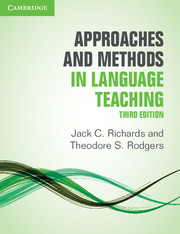Book contents
- Frontmatter
- Contents
- Acknowledgments
- Introduction to the third edition
- I Major trends in twentieth-century language teaching
- II Current approaches and methods
- III Alternative twentieth-century approaches and methods
- IV The teaching and learning environment
- Appendix: Comparison of approaches and methods
- Author index
- Subject index
16 - The Silent Way
Published online by Cambridge University Press: 08 April 2022
- Frontmatter
- Contents
- Acknowledgments
- Introduction to the third edition
- I Major trends in twentieth-century language teaching
- II Current approaches and methods
- III Alternative twentieth-century approaches and methods
- IV The teaching and learning environment
- Appendix: Comparison of approaches and methods
- Author index
- Subject index
Summary
Introduction
While some of the teaching methods that have gained prominence at different times represented the consensus of academics, language teaching specialists, and educational institutions and hence were often widely adopted, others have been the product of indi-vidual educators advocating a personal view of teaching and learning. Such is the case with the Silent Way. The Silent Way is the name of a method of language teaching devised by Caleb Gattegno (1911–1988). Gattegno's name is well known for his revival of interest in the use of colored wooden sticks called Cuisenaire rods and for his series Words in Color, an approach to the teaching of initial reading in which sounds are coded by specific colors. His reading materials are copyrighted and continue to be marketed through Educational Solutions Inc., in New York. The Silent Way represents Gattegno's venture into the field of foreign language teaching. As applied to language teaching, a Silent Way lesson progresses through a number of stages, beginning in a similar way with pronunciation practice and then moving to practice of simple sentence patterns, structure, and vocabulary. It is based on the premise that the teacher should be silent as much as possible in the classroom and the learner should be encouraged to produce as much language as possible. Elements of the Silent Way, particularly the use of color charts and the colored Cuisenaire rods, grew out of Gattegno's previous experience as an educational designer of reading and mathematics programs. (Cuisenaire rods were first developed by Georges Cuisenaire, a European educa-tor who used them for the teaching of math. Gattegno had observed Cuisenaire rods and this gave him the idea for their use in language teaching.) Working from what is a rather traditional structural and lexical syllabus, the Silent Way method exemplifies many of the features that characterize more traditional methods, such as Situational Language Teaching (Chapter 3) and Audiolingualism (Chapter 4), with a strong focus on accurate repetition of sentences, modeled initially by the teacher, and a movement through guided elicitation exercises to freer communication.
It is interesting to speculate that one of the reasons for the early popularity of the Silent Way in the United States and its use in official US Foreign Officer and Peace Corps training programs is that silence has been noted to be a stronger inducement to verbalization among Americans than for many other cultural groups.
- Type
- Chapter
- Information
- Approaches and Methods in Language Teaching , pp. 289 - 302Publisher: Cambridge University PressPrint publication year: 2014

